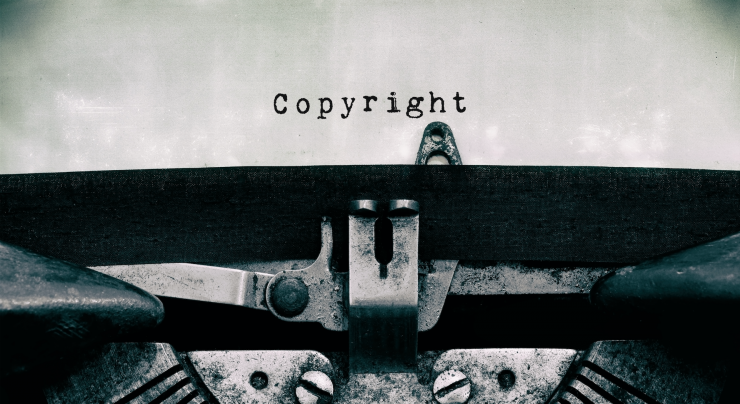You just completed the best script ever. Now you need to protect your baby before it’s stolen. Knowing how to copyright a script is a good idea as a screenwriter. The last thing anybody needs is a legal war over their work. Even though there’s a link to WGA to register your script on Final Draft, I recommend you take it a step further.
This blog post will tell you the most reliable way to protect your screenplay. I’ll inform you on copyrighting a script to have a record of ownership. In case you are a victim of theft, this information will give you recourse.
The first step to selling your screenplay is ironing out the legal aspects.
If you want credit, copyright your screenplay.
Let’s get down to business…
What Is A Copyright?

A copyright is a type of intellectual property that provides exclusive publication, distribution, and usage rights for the creator.
The Library of Congress handles copyrights in the U.S. Works of art that can be copyrighted are songs, plays, poems, scripts and audio-visual performances.
Decide Whether You Should Copyright Your Screenplay

If you’re like most screenwriters, when you type Fade To Black on a screenplay, you feel a wave of euphoria from the sense of accomplishment.
The work has only just begun because once you do that, you then need to make sure your script is protected.
Many try to protect themselves by using the WGA registration service.
But keep in mind, sending it to the WGA Registry is not akin to copyrighting your script.
Do you know how to copyright a movie idea? Well, it starts here for some.
Truthfully, the WGA only sets the date of creation despite several of the screenwriting apps providing a direct link.
Maybe this is the only protection needed and hell, it beats not getting it registered, right?
But keep in mind, a screenwriter in a court of law will need more than just a WGA script registration.
For this reason, the first question shouldn’t be “how to copyright a script,” but rather, “is the WGA registration process sufficient?”
There’s three reasons why it’s imperative that you go above and beyond to copyright your script:
- Ownership can’t be contested without a copyright.
- Statutory damages can’t be received if a copyright is filed after a lawsuit is filed.
- Ownership is proven by the copyright within five years of publication.
WGA registration doesn’t offer any of these things.
The official chain of title will be needed to sell your screenplay.
WHAT IS A CHAIN OF TITLE?
It’s a particular order of transfers of an intellectual property.
The best way to set a chain of title is to copyright your screenplay.
When it comes to copyrighting, it’s a matter of when, not if.
A WGA registration might be fine if you’re not submitting to anyone. Also, think about trying the “poor man’s copyright.”
All this requires is you mailing it to yourself.
Don’t open it when you receive it back.
It’s time to officially copyright your script if you’re ready to sell. It’s scary having to share your work with agents, managers, producers, friends, relatives, and strangers. With a copyright, you’ll have no fear since you’ll be protected.
How To Copyright A Screenplay
Fear not. Copyrighting your screenplay is fairly easy. Step 1 is to go to the Library of Congress Office website.
Once there, it guides you to enter your name, contact information, and other details like your user ID and password.
A quick heads up, information provided on your copyright registration will be accessible to the public.
Once the account is set up, your script can be copyrighted. You’ll head to the
“Register a Work” tab first.
Register your screenplay as a work of Performing Arts, NOT a motion picture. Only register as a motion picture after your script is filmed. (That’s coming later.)
Give the information that’s needed on the application form. These include:
- Title of Work
- Year of Completion
- Name(s) of Author(s)
As previously mentioned, it’s easy to copyright a script, but there’s more steps to finish the procedure.
Save as you go in the event that you have to stop and come back later.
Pay The Fees To Copyright The Screenplay
It’s time to pay for the service after you’ve reviewed the submission details. For this step, you’ll leave the Library of Congress site.
Put in the information for payment. It costs $35. That’s only $15 more than registration for the WGA and gives you more protection. A minute price for your work to be 100% owned by you.
Create a shipping slip for the electronically uploaded deposit. It’s not mandatory to generate the slip, but you’ll have a digital receipt of your registration.
Who Handles Copyright Filing?
LegalZoom will take care of your copyright filing fees. Unfortunately, it’ll be at triple the cost. They’ll ask the same questions causing you to lose money and time.
You’ll want to keep the digital receipt on hand since you’ll be waiting for the certification to come in the mail.
Wait For Your Copyright Certificate To Arrive
It takes a while to receive the certificate so be ready.
Sometimes it takes up to 16 months for the Library of Congress to get back to you about the web sent copyright for your screenplay.
This is explained well on their website.
You heard that right; 16 months. It’s a long time to copyright a screenplay. But don’t fret. The second the payment is processed, the claim of copyright is set.
This means your script is without a doubt yours even though you won’t see the actual documentation for a long long time.
Keep writing as you wait.
Receive The Copyright For Your Script
There’ll be an envelope when you go to the mailbox several months after finishing the steps to my how to copyright a screenplay guide.
You can celebrate after opening it for the fact that the United States Library of Congress has officially recognized the material you sent as your own.
Congratulations! Your screenplay is copyrighted.
Leave A Comment
As you know, this site is dedicated to helping screenwriters. To help out our fellow screenwriters, leave a comment to make the content easier to find.
Related:
- 11 Of The Best Places To Write In LA
- 3 Things Every Screenwriter Needs
- 5 Ways To Sell Your Screenplay
- Could Someone Steal Your Script Idea?
- How To Write A Flashback In A Script
- How To Become A Screenwriter
- How To Create Characters In A Screenplay
- How To Format A Script
- How To Write A Screenplay Treatment
- Are Screenwriting Pitch Sites Worth It?
- How To Become A Screenwriter
- 20 Great Ways To Come Up With Script Ideas
- How To Write Sexual Tension
- Benefits of Blue Light Blocking Glasses From Knockaround
- How Long Should a Screenplay Be?


Leave a Reply